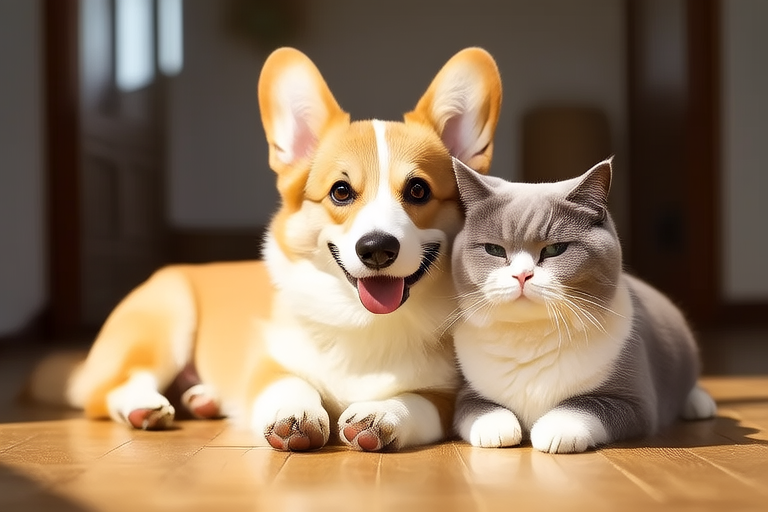The World of Munchkin Dogs and Cats: A Journey Through Short-Legged Charm
Welcome to the fascinating realm of Munchkin dogs and cats, where diminutive stature meets giant personalities. These endearing creatures have captured the hearts of many with their unique physical characteristics and unwavering loyalty. In this article, we explore the history, physical traits, health considerations, common breeds, and popular misconceptions surrounding Munchkin pets. We also share anecdotes from owners and provide insights into their care requirements and integration into family life.
A Brief History of Munchkins
Munchkin cats first gained attention in the early 1990s when a Louisiana woman discovered a litter of kittens with unusually short legs. The breed was officially recognized by The International Cat Association (TICA) in 2003. Munchkin dogs, on the other hand, emerged more recently, with the first documented breed being the Basset-type Beagle in the 19th century. Both Munchkin cats and dogs owe their distinctive appearance to a genetic mutation that affects the growth plate in their long bones, resulting in shorter limbs.
Physical Traits and Health Considerations
One of the most striking features of Munchkin dogs and cats is their short legs. While this trait makes them adorable, it can also lead to certain health issues. For instance, Munchkin cats may experience lordosis, a condition characterized by an abnormal curvature of the spine, and pectus excavatum, a chest deformity. Similarly, Munchkin dogs are prone to joint problems and spinal issues due to their shorter leg length.
Despite these challenges, many Munchkin pets live long and healthy lives with proper care. Regular vet check-ups, a balanced diet, and exercise tailored to their specific needs can help mitigate potential health risks. It’s important for potential owners to understand the commitment involved in caring for these unique animals.
Common Breeds of Munchkin Dogs and Cats
There are several breeds of Munchkin dogs and cats, each with its own set of characteristics. Some popular Munchkin cat breeds include:
- Munchkin Cats: Known for their playful and affectionate nature, Munchkin cats come in various coat colors and patterns. They are generally friendly towards humans and other animals.
- Munchkin Longhair Cats: This breed is similar to the Munchkin but has longer fur. They require more grooming than their shorthaired counterparts.
- Munchkin British Shorthair Cats: These cats are known for their calm demeanor and plush coats. They make excellent companions for families with children.
Popular Munchkin dog breeds include:
- Basset Hounds: Renowned for their long ears and short legs, Basset Hounds are gentle giants with a friendly disposition.
- Dachshunds: Often referred to as “wiener dogs,” Dachshunds are energetic and intelligent. They come in three sizes: standard, miniature, and kaninchen.
- Corgis: Corgis are beloved for their stocky build and cheerful personality. They are loyal and protective of their families.
Popular Misconceptions About Munchkin Pets
Despite their growing popularity, there are still many misconceptions about Munchkin dogs and cats. One common myth is that all Munchkin pets are unhealthy or prone to severe health problems. While it’s true that some health issues are associated with their unique physiology, many Munchkin pets live happy, healthy lives with proper care.
Another misconception is that Munchkin pets are lazy or inactive. In reality, many Munchkin dogs and cats are quite active and enjoy playing and exploring. They may require shorter walks or less intense play sessions compared to taller breeds, but they still need regular exercise to maintain their health.
Anecdotes from Owners
Many owners of Munchkin pets attest to their charm and adaptability. Sarah, a Munchkin cat owner, shares her story: “My Munchkin cat, Luna, is full of energy despite her short legs. She loves to chase toys and curl up with me on the couch. She’s incredibly affectionate and always knows when I need a little extra love.” John, who owns a Munchkin dog, echoes similar sentiments: “Our Dachshund, Max, is always up for a game of fetch. He may be small, but he’s got a big heart and a lot of spirit.”
Care Requirements and Integration Into Family Life
Munchkin pets require special care to ensure their well-being. Providing them with a comfortable living environment, a nutritious diet, and regular exercise is essential. Many owners find that Munchkin pets adapt well to family life, becoming cherished members of the household. Their size makes them ideal for apartment living, and their playful nature ensures endless entertainment.
Comparing Munchkin Dogs and Cats
While both Munchkin dogs and cats share the characteristic of short legs, there are notable differences between the two. Munchkin dogs tend to be more active and require more exercise than their feline counterparts. They also have a stronger prey drive, making them less suitable for households with small pets like birds or rodents.
Munchkin cats, on the other hand, are often more independent and self-sufficient. They enjoy climbing and exploring but can also be content lounging around the house. Their shorter legs don’t hinder their ability to jump or climb, as they compensate with increased flexibility.
Both Munchkin dogs and cats are social animals that thrive on human interaction. They form strong bonds with their owners and are often described as loving and devoted companions. Their adaptability and resilience make them excellent pets for a wide range of families.
Conclusion
The world of Munchkin dogs and cats is a testament to the diversity and wonder of animal life. These short-legged, big-hearted pets bring joy and companionship to countless households worldwide. By understanding their unique needs and providing them with proper care, owners can ensure that their Munchkin pets lead happy, healthy lives. Whether you’re a seasoned pet enthusiast or considering adopting your first Munchkin pet, these remarkable animals are sure to capture your heart.
